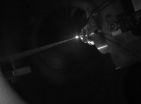(Press-News.org) Because of results seen in flat lab dishes, biologists have believed that cancers cells move through the body in a slow, aimless fashion, resembling an intoxicated person who cannot walk three steps in a straight line. This pattern, called a random walk, may hold true for cells traveling across two-dimensional lab containers, but Johns Hopkins researchers have discovered that for cells moving through three-dimensional spaces within the body, the "drunken" model doesn't hold true.
This finding, reported in the March 4 online Early Edition of Proceedings of the American Academy of Sciences, is important because it should lead to more accurate results for scientists studying how cancer spreads through the body, often leading to a grim prognosis. To address this dimensional disagreement, the study's authors have produced a new mathematical formula that they say better reflects the behavior of cells migrating through 3D environments.
The research was supervised by Denis Wirtz, the university's Theophilus H. Smoot Professor, with appointments in the departments of Chemical and Biomolecular Engineering, Pathology and Oncology within Johns Hopkins' Whiting School of Engineering and School of Medicine. Wirtz said the discovery reinforces the current shift toward studying how cells move in three dimensions. His lab team has conducted earlier studies showing that that cells in 2D and 3D environments behave differently, which affects how cancer migrates within the body.
"Cancer cells that break away from a primary tumor will seek out blood vessels and lymph nodes to escape and metastasize to distant organs," Wirtz said. "For a long time, researchers have believed that these cells make their way to these blood vessels through random walks. In this study, we found out that they do not. Instead, we saw that these cells will follow more direct, almost straight-line trajectories. This gives them a more efficient way to reach blood vessels -- and a more effective way to spread cancer."
For researchers trying to understand how metastasis occurs, he added, this discovery has critical implications.
"This means that the time these cancer cells need to make their way out of connective tissues is much shorter than previous estimates," said Wirtz, who was recently named the university's vice provost for research.
The co-lead authors on the PNAS paper were Pei-Hsun Wu, a postdoctoral fellow, and Anjil Giri, a doctoral student, both in the Department of Chemical and Biomolecular Engineering.
Wu said the team knew that the Persistent Random Walk math model, developed for characterizing cell movements in flat Petri dishes, was also being used in 3D testing, yielding questionable results in the latter.
"It has been used for both kinds of experiments because it's easy and convenient," Wu said. "But it really doesn't fit well when you are working in 3D. Our new math model works better in both 2D and 3D testing."
The researchers discovered that cells in a 3D matrix exhibit different magnitudes of movement in different directions. To address this, the team members enhanced the original formula by identifying the primary and secondary directions in which the cells move, along with the speeds at which the cells travel and their persistence. In cell studies, persistence refers to how far the cells move in a fairly straight line before changing direction.
"Cells that are moving through a 3D environment seem to be more directional than those moving across a flat 2D surface," co-lead author Giri said. "The unpredictable 'random walk' is not prevalent in a 3D environment."
The team's improved math model for studying cell migration was published with their journal article, and the researchers hope other scientists who are trying to understand and prevent cancer metastasis will quickly adopt it. Although the team members used fibrosarcoma cancer cells in the PNAS study, they said the new model can also be used to help understand the behavior of other cell types, including those that move through the body to help fight infections and to speed the healing of wounds.
INFORMATION:
Coauthors of the study were Sean X. Sun, an associate professor in the Whiting School's Department of Mechanical Engineering, and Wirtz, who directs the Johns Hopkins Physical-Sciences Oncology Center and is affiliated with the School of Medicine's Sidney Kimmel Comprehensive Cancer Center. The research was supported by National Institutes of Health Grants R01CA174388 and U54CA143868.
Short video of cell movements at: http://youtu.be/UOk2VomIxWQ
Related links:
The PNAS journal article is at:
http://www.pnas.org/content/early/2014/03/04/1318967111.full.pdf+html
From Johns Hopkins Magazine:
Moving cancer research out of the Petri dish and into the third dimension
http://hub.jhu.edu/magazine/2013/winter/cancer-in-3d
Johns Hopkins Physical Sciences-Oncology Center: http://psoc.inbt.jhu.edu/
Wirtz Lab Website: http://web1.johnshopkins.edu/wirtzlab/
Johns Hopkins Kimmel Cancer Center: http://www.hopkinskimmelcancercenter.org/
Cancer cells don't take 'drunken' walks through the body
2014-03-11
ELSE PRESS RELEASES FROM THIS DATE:
Research consortium identifies predictors of successful ACL reconstruction
2014-03-11
Tuesday, March 11, 2014 Cleveland: Researchers have found that a patient's age and the type of tissue graft have a direct impact on ACL reconstructive surgery (ACLR) outcomes, according to an exhibit presented March 11 at the 2014 American Academy of Orthopaedic Surgeons (AAOS) annual meeting in New Orleans.
Researchers from Cleveland Clinic and six other member institutions will present findings on surgical reconstruction of anterior cruciate ligaments from the Multicenter Orthopaedics Outcomes Network (MOON), led by Cleveland Clinic's Kurt Spindler, M.D., principal ...
Anesthetic technique improves quality of recovery for women having breast cancer surgery
2014-03-11
TORONTO, March 11, 2014 – Anesthesiologists using a technique similar to a dental freeze can improve the quality of recovery and decrease recovery time for breast cancer surgery patients, according to a new study.
The study, from researchers at St. Michael's Hospital and Women's College Hospital, was published in the March edition of Anesthesiology. It is the world's first randomized control trial for breast cancer surgery that compares the use of ultrasound-guided paravertebral blocks – a local anesthetic freezing that blocks breast nerves – to general anesthetic. The ...
LED lamps: Less energy, more light
2014-03-11
Incandescent light bulbs are now banned in the EU, while energy-saving lamps remain a bone of contention. In 2016, it will be lights out for halogen bulbs over 10 watts as well. LEDs (light-emitting diodes) therefore have the best chance of becoming the light source of the future. Experts reckon that LED retrofit lamps for use in standard bulb fittings will overtake traditional energy-saving bulbs for the first time from 2015. By 2020 it is predicted that LEDs will have captured between 88 and 90 percent of the lighting market. The tiny diodes offer a whole host of advantages ...
X-ray laser FLASH spies deep into giant gas planets
2014-03-11
This news release is available in German.
The atmosphere of gas giants consists mainly of hydrogen, which is the most abundant chemical element in the universe. "We have very little experimental knowledge about the hydrogen in the interior of such planets," says Zastrau. "This is despite our very good theoretical models." The researchers therefore decided to use cold liquid hydrogen as a sample of the planetary atmosphere. "Liquid hydrogen has a density that corresponds to that of the lower atmosphere of such giant gas planets," explains Zastrau. The scientists ...
Cosmetic treatment can open the door to bacteria
2014-03-11
Many people have 'fillers' injected into their facial tissue to give them 'bee-stung lips' or to smooth out their wrinkles. Unfortunately, a lot of cosmetic treatment customers experience unpleasant side effects in the form of tender subcutaneous lumps that are difficult to treat and which - in isolated cases - have led to lesions that simply will not heal. Research recently published by the University of Copenhagen now supports that, despite the highest levels of hygiene, this unwanted side effect is caused by bacterial infection.
Injections of fillers were previously ...
Metallurgical challenges in microelectronic 3D IC packaging technology
2014-03-11
Mobile hand-held consumer electronic products have a rapid growing market today, witnessed by the popularity of Apple products. Most people make their first contact to internet, not by a PC, rather by a smart phone. The phone is no longer a phone, but it provides various functions for communication and for entertainment. Not only we can have recorded information such as books, images, songs, and movies from the phone or i-pad, but also we can have instant information such as traffic jam when we drive home, as well as breaking news at the last moment. It is expected that ...
Type 1 diabetes in adults: Antibody affinity is decisive
2014-03-11
LADA (latent autoimmune diabetes in adults) is a form of type 1 diabetes in adulthood. Like the childhood form, the insulin-producing beta cells of the pancreas are destroyed by the body's own immune system. The progression of the illness is relatively slowly, however, with clinical manifestations not appearing until after the age of 30 and the patients not yet requiring insulin therapy to control blood sugar levels at the beginning of the disease. It is therefore often difficult to differentiate between LADA and type 2 diabetes.
Scientists from the Institute of Diabetes ...
California and Arizona amaze with 2 new species of desert poppy
2014-03-11
Who said that there is only sand in the deserts? Not quite desert roses, two new species of desert poppies from North America prove such statements wrong with their simple beauty. The newly described plants are found in the deserts of California and Arizona and have a vibrant yellow colored inflorescences, typical for all the desert dwellers from the Eschscholzia genus of the poppy family. The study was published in the open access journal PhytoKeys.
Most commonly known for the iconic California Poppy, the state flower of California, Eschscholzia is a genus in the poppy ...
Exotic plant species alter ecosystem productivity
2014-03-11
This news release is available in German.
Halle, Germany/ Missoula, USA/ Berkeley, USA. In their joint publication in the journal „Ecology Letters" German and American biologists have reported an increase in biomass production in ecosystems colonised by non-native plant species. In the face of climate change, these and other changes to ecosystems are predicted to become more frequent, according to the researchers.
All over the world, plant and animal species are increasingly encroaching upon ecosystems where they don't belong as a result of human influence. This ...
Getting hyperspectral image data down to a sprint
2014-03-11
Cameras with hyperspectral sensors can observe far more than the human eye. Unlike the retina, which has only three color receptors (red, green and blue), these sensors can generate 130 different color values per pixel. Using this high-grade color resolution, an entire range of different materials can be differentiated impeccably – even if, at first glance, they appear the same to the human eye. This is because every substance has its own individual color spectrum, irrespective of how its surface reflects the light hitting it. This hyperspectral technology can be used anyplace ...





